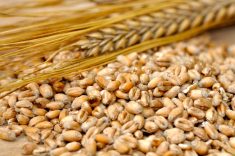MarketsFarm – As old crop stocks of feed barley and feed wheat continue to dwindle, the realization of reduced yields is now supporting bids for new crop.
“Down here, there are a few guys that are starting to pull off some barley here in the next little bit. You’re going to find that the barley that’s coming off is going to be fairly light though,” said Mike Fleischhauer of Eagle Commodities in Lethbridge, Alta.
“Right now, we are kind of sitting at C$390 per tonne for barley and running around the same for wheat. We’re right around the corner for new crop. I don’t think there’s enough expected to come off from new crop as good quality and that’s keeping the price up,” he added.
Read Also

U.S. grains: Soybeans touch 16-month high, wheat firm on Chinese demand hopes
Chicago soybean futures hit 16-month highs on Monday on expectations China will restart large-scale U.S. soy buying after the two countries reached a deal to de-escalate their trade war.
The high-delivered bid for feed barley in Alberta traded at C$9.04 per bushel (C$415.21 per tonne), an increase of C$1.68 from last month and C$3.81 from last year, according to Prairie Ag Hotwire data from July 28. As for Alberta feed wheat, the high-delivered bid was C$11.29/bu. (C$414.84/tonne), which rose from C$9.25/bu. last month and from C$6.66/bu. at this time last year.
Fleischhauer believes prices will remain elevated at least until the corn harvest this fall.
“You’re going to have corn that’s going to supplement (feed grains), but that’s not coming off until November. The new crop prices are trading a fair bit higher because there’s nothing to supplement it at this point,” he explained, adding that feedlot demand is slowly increasing.
“We’ve got three months or so we have to get through, and that’s the problem. You’re going to start seeing some of the feedlots having to take some light barley or they’re going to discount the light barley,” Fleischhauer said.












